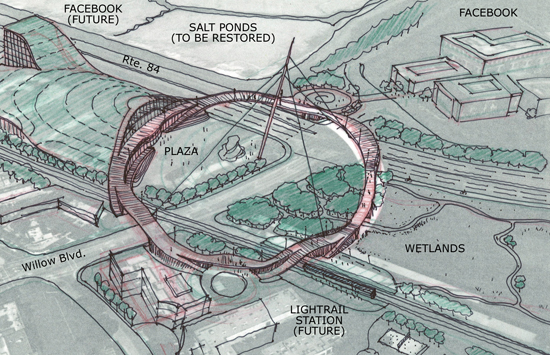Facebook recently held a hack-a-thon for its new campus.
Hoping to Win Over a Town, Facebook Holds Urban Planning "Hack-a-thon"
Facebook is moving from tony Palo Alto to blue-collar Belle Haven, and they want to woo residents with community-oriented design.
Some social networks still function better in the flesh, and so, on Saturday, Facebook played host to a massive “design charrette” that brought four busloads of architects, designers, and urban planners together for an all-day cram session devoted to re-imagining Menlo Park’s Belle Haven community, soon-to-be home of the company’s global headquarters.
Here are one of the concepts.
We asked him what ideas particularly fired his fancy. “I like the idea of taking advantage of the bay land right next door,” he said. “I like the idea of connecting the rail line, which right now isn’t active. If it was active, we could use that to get Facebook employees to the campus.”
[Team Red's "Circle of Friends" concept]
Crowd-sourcing was applied to come up with new ideas.
Facebook says it wants to change the fortress vibe and embrace the community. So to kick things off on Saturday, designers took morning bus tours of the adjacent Belle Haven neighborhood -- several dozen local residents came along to lend their thoughts -- and then broke into Red, Yellow, Blue, and Green teams. Teams of 20 to 40 each rolled up their T-shirts and began cranking out as many hand sketches and digital models as they could before an after-dinner deadline: a show-your-work presentation before a packed assembly of fellow architects, Facebook reps, Menlo Park city officials, and a sprinkling of nearby residents. The day’s mission, as Norman tells it: “creating a sense of community” -- or perhaps, more to the point, to create a larger sense of community, one that very conspicuously features Facebook.
[Another concept, for a footbridge linking the campus with the surrounding blocks]
Why can’t the same be applied to a data center design? Too radical of an idea. Let’s see who likes and dislikes the idea?


